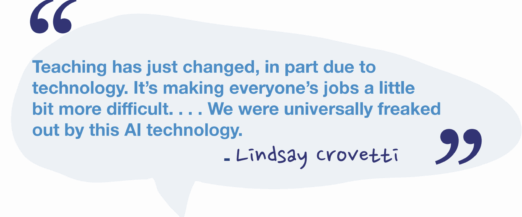A Guide to AI in Schools:
Perspectives for the Perplexed
by educators and for educators
Most new technologies, like laptops, are adopted in schools as the result of a deliberate policy choice. But generative AI is different: it is an arrival technology, which means that it arrived without formal adoption – students and teachers simply began using it. This arrival has left schools scrambling to respond to many challenges, including questions about academic integrity and data privacy.
This guidebook is designed to support teachers and other school leaders as they determine what AI policies or guidelines to craft.
![JensenQuote “[AI is] accelerating so fast, and we are struggling to catch up to it.” – Alec Jensen](https://tsl.mit.edu/wp-content/uploads/brizy/imgs/JensenQuote-scaled-480x163x0x4x480x156x1754505877.png)
Justin Reich (Director of the Teaching Systems Lab) notes, “A guidebook of tying knots will show you exactly how to tie the knots the correct way. A guidebook on AI in schools in 2025 can’t possibly do that because we don’t even know what the knots are, let alone how to tie them. What we can show you is how people are taking this new kind of rope and bending it around in interesting ways, some of which might prove sturdy and some of which might prove faulty. And we won’t know which is which for a long time.”
This guidebook is not meant to be prescriptive or definitive. Rather, we envision it as akin to an invitation to observe a conversation in the teacher’s lounge about how teachers think about AI, what they are seeing in their classrooms, and what they’ve tried and how it went. We include a lot of case studies – we hope these will spark thought and discussion, allowing you to draw from other schools’ experiences. We also liberally excerpted statements from the interviews we conducted in order to center teachers’ voices in this conversation.


